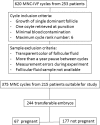Anti-oxidative function of follicular fluid HDL and outcomes of modified natural cycle-IVF
- PMID: 31492916
- PMCID: PMC6731220
- DOI: 10.1038/s41598-019-49091-3
Anti-oxidative function of follicular fluid HDL and outcomes of modified natural cycle-IVF
Abstract
High density lipoproteins (HDL) are the main cholesterol carriers in follicular fluid (FF), the natural environment of oocyte development. Additionally, HDL have critical biological functions such as anti-oxidative capacity, which have not been studied in reproduction. Therefore, this study aimed to investigate whether the anti-oxidative function of FF-HDL is associated with fertility outcomes. From 253 women undergoing modified natural cycle (MNC)- IVF at a single academic centre FF and plasma were collected (n = 375 cycles). Anti-oxidative function of FF was mainly attributable to HDL (n = 8; 83%). FF-HDL had a higher anti-oxidative function than plasma HDL (n = 19, P < 0.001) coinciding with increased vitamin E and sphingosine 1 phosphate content (P = 0.028 each). Proteomic analysis indicated no significant differences in major anti-oxidative proteins such as paraoxonase 1, apolipoprotein (apo) A-I or apoA-IV between FF-HDL and matched plasma-HDL (n = 5), while apoC-III, apoE and apoC-II were relatively lower in FF-HDL. Finally, FF-HDL anti-oxidative function was related to a decrease in the odds of the oocyte undergoing normal fertilization, an association that persisted after adjustment for confounders (odds ratio 0.97 (0.93-1), P = 0.041). In conclusion, FF-HDL has considerable anti-oxidative properties that might be relevant for embryo quality.
Conflict of interest statement
A.H. declares that the Department of Obstetrics and Gynaecology of the University Medical Groningen received an unrestricted educational grant of Ferring Pharmaceutical BV, the Netherlands. R.A.N., A.P.A.vM., H.G., I.H., D.A., R.H.M., J.L.C.A. and U.J.F.T. declare no potential conflict of interest.
Figures


Similar articles
-
Oocyte matched follicular fluid anti-Müllerian hormone is an excellent predictor of live birth after fresh single embryo transfer.Hum Reprod. 2019 Nov 1;34(11):2244-2253. doi: 10.1093/humrep/dez186. Hum Reprod. 2019. PMID: 31725884
-
HDL functionality in follicular fluid in normal-weight and obese women undergoing assisted reproductive treatment.J Assist Reprod Genet. 2019 Aug;36(8):1657-1664. doi: 10.1007/s10815-019-01523-9. Epub 2019 Jul 23. J Assist Reprod Genet. 2019. PMID: 31338723 Free PMC article.
-
Associations between follicular fluid high density lipoprotein particle components and embryo quality among in vitro fertilization patients.J Assist Reprod Genet. 2017 Jan;34(1):1-10. doi: 10.1007/s10815-016-0826-x. Epub 2016 Nov 29. J Assist Reprod Genet. 2017. PMID: 27900613 Free PMC article.
-
High-density lipoprotein metabolism and the human embryo.Hum Reprod Update. 2010 Jan-Feb;16(1):20-38. doi: 10.1093/humupd/dmp029. Hum Reprod Update. 2010. PMID: 19700490 Review.
-
Follicular fluid content and oocyte quality: from single biochemical markers to metabolomics.Reprod Biol Endocrinol. 2009 May 4;7:40. doi: 10.1186/1477-7827-7-40. Reprod Biol Endocrinol. 2009. PMID: 19413899 Free PMC article. Review.
Cited by
-
Serum Lipid Levels and Treatment Outcomes in Women Undergoing Assisted Reproduction: A Retrospective Cohort Study.Front Endocrinol (Lausanne). 2021 Mar 8;12:633766. doi: 10.3389/fendo.2021.633766. eCollection 2021. Front Endocrinol (Lausanne). 2021. PMID: 33763032 Free PMC article.
-
The association between serum HDL levels and infertility among American women aged 20-44 years: A retrospective cross-sectional study of NHANES, 2013-2020.PLoS One. 2024 Oct 7;19(10):e0311618. doi: 10.1371/journal.pone.0311618. eCollection 2024. PLoS One. 2024. PMID: 39374238 Free PMC article.
-
Oxidative homeostasis in follicular fluid and reproductive outcomes - from bench to bedside.Prz Menopauzalny. 2022 Dec;21(4):276-284. doi: 10.5114/pm.2022.124019. Epub 2022 Dec 30. Prz Menopauzalny. 2022. PMID: 36704764 Free PMC article. Review.
-
Low vitamin D levels in follicular fluid, but not in serum, are associated with adverse outcomes in assisted reproduction.Arch Gynecol Obstet. 2022 Feb;305(2):505-517. doi: 10.1007/s00404-021-06174-9. Epub 2021 Aug 8. Arch Gynecol Obstet. 2022. PMID: 34368906
-
Differential Profile of Systemic Extracellular Vesicles From Sporadic and Familial Alzheimer's Disease Leads to Neuroglial and Endothelial Cell Degeneration.Front Aging Neurosci. 2020 Nov 11;12:587989. doi: 10.3389/fnagi.2020.587989. eCollection 2020. Front Aging Neurosci. 2020. PMID: 33281599 Free PMC article.
References
-
- Wallace M, et al. An investigation into the relationship between the metabolic profile of follicular fluid, oocyte developmental potential, and implantation outcome. Fertil. Steril. 2012;97(1078–84):e1–8. - PubMed
MeSH terms
Substances
LinkOut - more resources
Full Text Sources
Medical
Miscellaneous

